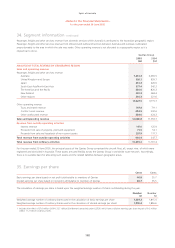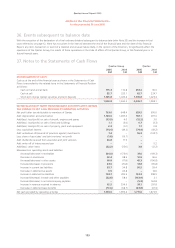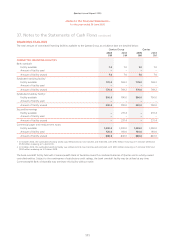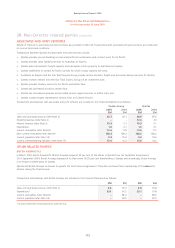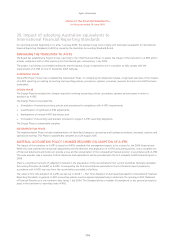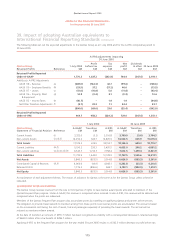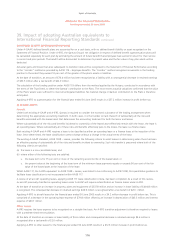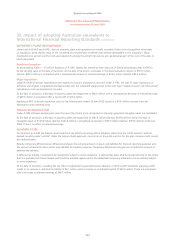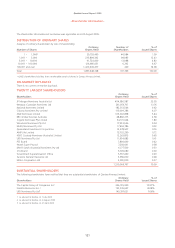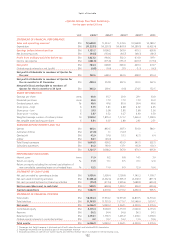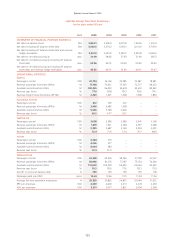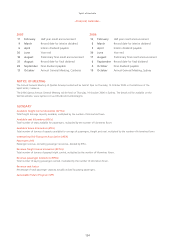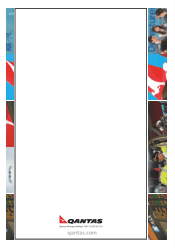Qantas 2005 Annual Report Download - page 119
Download and view the complete annual report
Please find page 119 of the 2005 Qantas annual report below. You can navigate through the pages in the report by either clicking on the pages listed below, or by using the keyword search tool below to find specific information within the annual report.117
39. Impact of adopting Australian equivalents to
International Financial Reporting Standards continued
(d) PROPERTY, PLANT AND EQUIPMENT
Under both A-GAAP and A-IFRS, items of property, plant and equipment are initially recorded at their cost of acquisition at the date
of acquisition, being the fair value of the consideration provided plus incidental costs directly attributable to the acquisition. Major
modifications to aircraft and the costs associated with placing the aircraft into service are capitalised as part of the cost of the asset to
which they relate.
Transition Exemption
As permitted by AASB 1 – First-Time Adoption of A-IFRS, Qantas has elected to deem the cost of land and buildings under A-IFRS to
be the carrying value at the date of transition. At the date of transition, a decrease in the asset revaluation reserve of $55.5 million
(Qantas: $82.9 million) is recognised with a consequential increase in retained earnings of $55.5 million (Qantas: $82.9 million).
Major Inspections
Under A-GAAP all aircraft maintenance and inspection costs are expensed as incurred. Under A-IFRS, the cost of major inspections of
airframes and engines is capitalised and depreciated over the scheduled usage period to the next major inspection event. All other aircraft
maintenance costs are expensed as incurred.
At the date of transition, a decrease in property, plant and equipment of $58.0 million with a consequential decrease in retained earnings
of $40.6 million is recognised after a tax benefit of $17.4 million.
Applying A-IFRS to aircraft inspection costs for the financial year ended 30 June 2005 results in a $0.4 million increase in aircraft
depreciation and operating costs.
Software Development Costs
Under A-IFRS software development costs that meet the criteria to be recognised as internally generated intangible assets are capitalised.
At the date of transition, a decrease in property, plant and equipment of $141.8 million (Qantas: $141.8 million) and an increase in
intangible assets of $141.8 million (Qantas: $141.8 million) is recognised increasing to $159.9 million (Qantas: $159.6 million) at 30 June
2005. There is no effect on retained earnings.
(e) INCOME TAXES
On transition to A-IFRS the balance sheet method of tax effect accounting will be adopted, rather than the ‘profit and loss’ method
applied currently under A-GAAP. Under the balance sheet approach, income tax on the profit and loss for the year comprises both current
and deferred taxes.
Broadly, temporary differences are differences between the carrying amount of assets and liabilities for financial reporting purposes and
the amount attributed to those assets and liabilities for taxation purposes. Temporary differences may give rise to deferred tax assets or
deferred tax liabilities.
A deferred tax liability is required to be recognised, subject to some exceptions. A deferred tax asset shall be recognised only to the extent
that it is probable that future taxable profits will be available against which the deductible temporary differrence can be utilised, subject
to some exceptions.
At the date of transition, excluding the tax effect of adjustments generated by the adoption of other A-IFRS standards, applying A-IFRS
results in an increase in deferred tax liability of $6.1 million and an increase in contributed capital of $40.6 million. These are recognised
after a decrease in retained earnings of $46.7 million.
Qantas Annual Report 2005
~Notes to the Financial Statements~
for the year ended 30 June 2005



